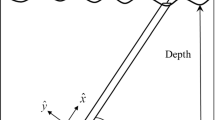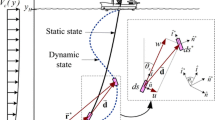Abstract
In this paper, we study the two-to-one internal resonance of an inclined marine riser under harmonic excitations. The riser is modeled as an Euler–Bernoulli beam accounting for mid-plane stretching, self-weight, and an applied axial top tension. Due to the inclination, the self-weight load causes a static deflection of the riser, which can tune the frequency ratio between the third and first natural frequencies near two. The multiple-time-scale method is applied to study the nonlinear equation accounting for the system nonlinearity. The solution is then compared to a Galerkin solution showing good agreement. A further investigation is carried out by plotting the frequency response curves, the force response curves, and the steady-state response of the multiple-time-scale solution, in addition to the dynamical solution obtained by Galerkin, as they vary with the detuning parameters. The results reveal that the riser vibrations can undergo multiple Hopf bifurcations and experience quasi-periodic motion that can lead to chaotic behavior. These phenomena lead to complex vibrations of the riser, which can accelerate its fatigue failure.















Similar content being viewed by others
References
Païdoussis, M.P., Price, S.J., De Langre, E.: Fluid-Structure Interactions: Cross-Flow-Induced Instabilities. Cambridge University Press, Cambridge (2010)
Lacarbonara, W., Arafat, H.N., Nayfeh, A.H.: Non-linear interactions in imperfect beams at veering. Int. J. Non-Linear Mech. 40(7), 987–1003 (2005). https://doi.org/10.1016/j.ijnonlinmec.2004.10.006
Öz, H.R., Pakdemirli, M.: Two-to-one internal resonances in a shallow curved beam resting on an elastic foundation. Acta Mech. 185(3), 245–260 (2006). https://doi.org/10.1007/s00707-006-0352-5
Nayfeh, A.H., Lacarbonara, W., Chin, C.-M.: Nonlinear normal modes of buckled beams: three-to-one and one-to-one internal resonances. Nonlinear Dyn. 18(3), 253–273 (1999). https://doi.org/10.1023/A:1008389024738
Chin, C., Nayfeh, A., Lacarbonara, W.: Two-to-one internal resonances in parametrically excited buckled beams. In: Proceedings of the 38th AIAA/ASME/ASCE/AHS/ASC Structures, Structural Dynamics, and Materials, pp. 7–10 (1997)
Chin, C.-M., Nayfeh, A.H.: Three-to-one internal resonances in hinged-clamped beams. Nonlinear Dyn. 12(2), 129–154 (1997). https://doi.org/10.1023/A:1008229503164
Benedettini, F., Rega, G., Vestroni, F.: Modal coupling in the free nonplanar finite motion of an elastic cable. Meccanica 21(1), 38–46 (1986). https://doi.org/10.1007/bf01556315
Perkins, N.C.: Modal interactions in the non-linear response of elastic cables under parametric/external excitation. Int. J. Non-Linear Mech. 27(2), 233–250 (1992). https://doi.org/10.1016/0020-7462(92)90083-J
Gattulli, V., Lepidi, M., Macdonald, J.H.G., Taylor, C.A.: One-to-two global-local interaction in a cable-stayed beam observed through analytical, finite element and experimental models. Int. J. Non-Linear Mech. 40(4), 571–588 (2005). https://doi.org/10.1016/j.ijnonlinmec.2004.08.005
Srinil, N., Rega, G.: Two-to-one resonant multi-modal dynamics of horizontal/inclined cables. Part II: internal resonance activation, reduced-order models and nonlinear normal modes. Nonlinear Dyn. 48(3), 253–274 (2007). https://doi.org/10.1007/s11071-006-9087-z
Srinil, N., Rega, G., Chucheepsakul, S.: Two-to-one resonant multi-modal dynamics of horizontal/inclined cables. Part I: theoretical formulation and model validation. Nonlinear Dyn. 48(3), 231–252 (2007). https://doi.org/10.1007/s11071-006-9086-0
Mansour, A., Mekki, O.B., Montassar, S., Rega, G.: Catenary-induced geometric nonlinearity effects on cable linear vibrations. J. Sound Vib. 413, 332–353 (2018). https://doi.org/10.1016/j.jsv.2017.10.012
Nayfeh, A.H.: Nonlinear Interactions: Analytical, Computational and Experimental Methods. Wiley, Hoboken (2000)
Mazzilli, C.E., Sanches, C.T., Neto, O.G.B., Wiercigroch, M., Keber, M.: Non-linear modal analysis for beams subjected to axial loads: analytical and finite-element solutions. Int. J. Non-Linear Mech. 43(6), 551–561 (2008). https://doi.org/10.1016/j.ijnonlinmec.2008.04.004
Tien, W.-M., Namachchivaya, N.S., Bajaj, A.K.: Non-linear dynamics of a shallow arch under periodic excitation–I. 1:2 internal resonance. Int. J. Non-Linear Mech. 29(3), 349–366 (1994). https://doi.org/10.1016/0020-7462(94)90007-8
Xiong, L.-Y., Zhang, G.-C., Ding, H., Chen, L.-Q.: Nonlinear forced vibration of a viscoelastic buckled beam with 2: 1 internal resonance. Math. Probl. Eng. (2014). https://doi.org/10.1155/2014/906324
Yi, Z., Wang, L., Kang, H., Tu, G.: Modal interaction activations and nonlinear dynamic response of shallow arch with both ends vertically elastically constrained for two-to-one internal resonance. J. Sound Vib. 333(21), 5511–5524 (2014). https://doi.org/10.1016/j.jsv.2014.05.052
Ma, J., Gao, X., Liu, F.: Nonlinear lateral vibrations and two-to-one resonant responses of a single pile with soil-structure interaction. Meccanica 52(15), 3549–3562 (2017). https://doi.org/10.1007/s11012-017-0681-6
Sahoo, B., Panda, L., Pohit, G.: Stability, bifurcation and chaos of a traveling viscoelastic beam tuned to 3: 1 internal resonance and subjected to parametric excitation. Int. J. Bifurc. Chaos 27(02), 1750017 (2017). https://doi.org/10.1142/S0218127417500171
Yu, T.-J., Zhang, W., Yang, X.-D.: Global dynamics of an autoparametric beam structure. Nonlinear Dyn. 88(2), 1329–1343 (2017). https://doi.org/10.1007/s11071-016-3313-0
Zhu, B., Dong, Y., Li, Y.: Nonlinear dynamics of a viscoelastic sandwich beam with parametric excitations and internal resonance. Nonlinear Dyn. 1–38 (2018). https://doi.org/10.1007/s11071-018-4511-8
Neto, O.B., Mazzilli, C.: Evaluation of multi-modes for finite-element models: systems tuned into 1: 2 internal resonance. Int. J. Solids Struct. 42(21), 5795–5820 (2005). https://doi.org/10.1016/j.ijsolstr.2005.03.026
Srinil, N., Wiercigroch, M., O’Brien, P.: Reduced-order modelling of vortex-induced vibration of catenary riser. Ocean Eng. 36(17–18), 1404–1414 (2009). https://doi.org/10.1016/j.oceaneng.2009.08.010
Srinil, N.: Multi-mode interactions in vortex-induced vibrations of flexible curved/straight structures with geometric nonlinearities. J. Fluids Struct. 26(7–8), 1098–1122 (2010). https://doi.org/10.1016/j.jfluidstructs.2010.08.005
Srinil, N.: Analysis and prediction of vortex-induced vibrations of variable-tension vertical risers in linearly sheared currents. Appl. Ocean Res. 33(1), 41–53 (2011). https://doi.org/10.1016/j.apor.2010.11.004
Chatjigeorgiou, I.K., Mavrakos, S.A.: Nonlinear resonances of parametrically excited risers–numerical and analytic investigation for \(\Omega \) = 2\(\omega \)1. Comput. Struct. 83(8–9), 560–573 (2005). https://doi.org/10.1016/j.compstruc.2004.11.009
Franzini, G., Mazzilli, C.: Non-linear reduced-order model for parametric excitation analysis of an immersed vertical slender rod. Int. J. Non-Linear Mech. 80, 29–39 (2016). https://doi.org/10.1016/j.ijnonlinmec.2015.09.019
Zhang, Y.-L., Chen, L.-Q.: Steady-state response of pipes conveying pulsating fluid near a 2: 1 internal resonance in the supercritical regime. Int. J. Appl. Mech. 6(05), 1450056 (2014). https://doi.org/10.1142/S1758825114500562
Wilson, J.F., Biggers, S.B.: Responses of submerged, inclined pipelines conveying mass. J. Eng. Ind. 96(4), 1141–1146 (1974). https://doi.org/10.1115/1.3438488
Alfosail, F.K., Nayfeh, A.H., Younis, M.I.: An analytic solution of the static problem of inclined risers conveying fluid. Meccanica 52(4), 1175–1187 (2016). https://doi.org/10.1007/s11012-016-0459-2
Alfosail, F.K., Nayfeh, A.H., Younis, M.I.: Natural frequencies and mode shapes of statically deformed inclined risers. Int. J. Non-Linear Mech. 94, 12–19 (2017). https://doi.org/10.1115/imece2016-66009
Khalak, A., Williamson, C.H.K.: Motions, forces and mode transitions in vortex-induced vibrations at low mass-damping. J. Fluids Struct. 13(7), 813–851 (1999). https://doi.org/10.1006/jfls.1999.0236
Facchinetti, M.L., de Langre, E., Biolley, F.: Coupling of structure and wake oscillators in vortex-induced vibrations. J. Fluids Struct. 19(2), 123–140 (2004). https://doi.org/10.1016/j.jfluidstructs.2003.12.004
Nayfeh, A.H.: Resolving controversies in the application of the method of multiple scales and the generalized method of averaging. Nonlinear Dyn. 40(1), 61–102 (2005). https://doi.org/10.1007/s11071-005-3937-y
Nayfeh, A.H.: Introduction to Perturbation Techniques. Wiley, Hoboken (2011)
Cheney, E., Kincaid, D.: Numerical Mathematics and Computing. Cengage Learning, Boston (2012)
Balachandran, B., Nayfeh, A.: Cyclic motions near a Hopf bifurcation of a four-dimensional system. Nonlinear Dyn. 3(1), 19–39 (1992). https://doi.org/10.1007/BF00045469
. Wolfram Research, I.: Mathematica. In, vol. Version 10.1. Wolfram Research, Inc., Champaign, Illinois, (2015)
Nayfeh, A.H., Mook, D.T.: Nonlinear Oscillations. Wiley, Hoboken (2008)
Acknowledgements
We acknowledge the financial support of King Abdullah University of Science and Technology and Saudi Aramco.
Author information
Authors and Affiliations
Corresponding author
Ethics declarations
Conflicts of interest
The authors declare that they have no conflict of interest.
Electronic supplementary material
Below is the link to the electronic supplementary material.
Appendices
Appendix A: Self-adjoint proof
In this appendix, we demonstrate by virtue of using integration by parts that the solution to the linear Eq. (13) is self-adjoint. Due to the internal resonance interaction, the solution to be utilized consists of two modes, namely \(\phi _m \left( x \right) \hbox {e}^{\pm i\omega _m T_0 }\) and \(\phi _n \left( x \right) \hbox {e}^{\pm i\omega _n T_0 }\) corresponding to modes m and n, respectively. To verify that the problem is self-adjoint, we substitute the solutions from both modes in Eq. (13) and, multiply the equation with \(\phi _j \left( x \right) \hbox {e}^{\pm i\omega _j T_0 }\), then integrate by parts from \(x=0\) to \(x=1\) to obtain
We observe from Eq. (1) that the solution \(\phi _j \left( x \right) \hbox {e}^{\pm i\omega _j T_0 }\) satisfies the eigenvalue problem Eq. (10) and it is self-adjoint.
Appendix B: definition of third-order solvability condition coupling coefficients
In this appendix, we provide the definition of the coupling coefficients \(K_1 \), \(K_2 \), \(K_3 \), and \(K_4 \) pertaining to Eqs. (30) and (31) given by
Appendix C: Time history of modal coefficients pertaining to the Galerkin solution
In this appendix, we plot the modal coefficients corresponding to the riser solution in Fig. 13, which has weak or negligible contribution (Fig. 16).
Rights and permissions
About this article
Cite this article
Alfosail, F.K., Younis, M.I. Two-to-one internal resonance of an inclined marine riser under harmonic excitations. Nonlinear Dyn 95, 1301–1321 (2019). https://doi.org/10.1007/s11071-018-4630-2
Received:
Accepted:
Published:
Issue Date:
DOI: https://doi.org/10.1007/s11071-018-4630-2





